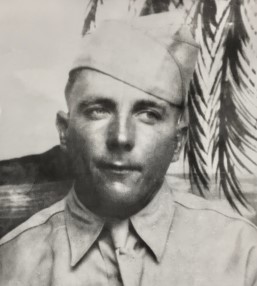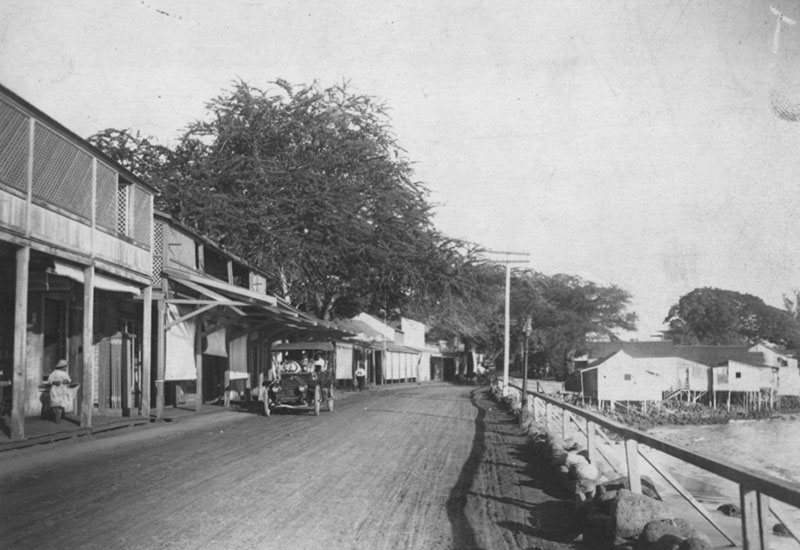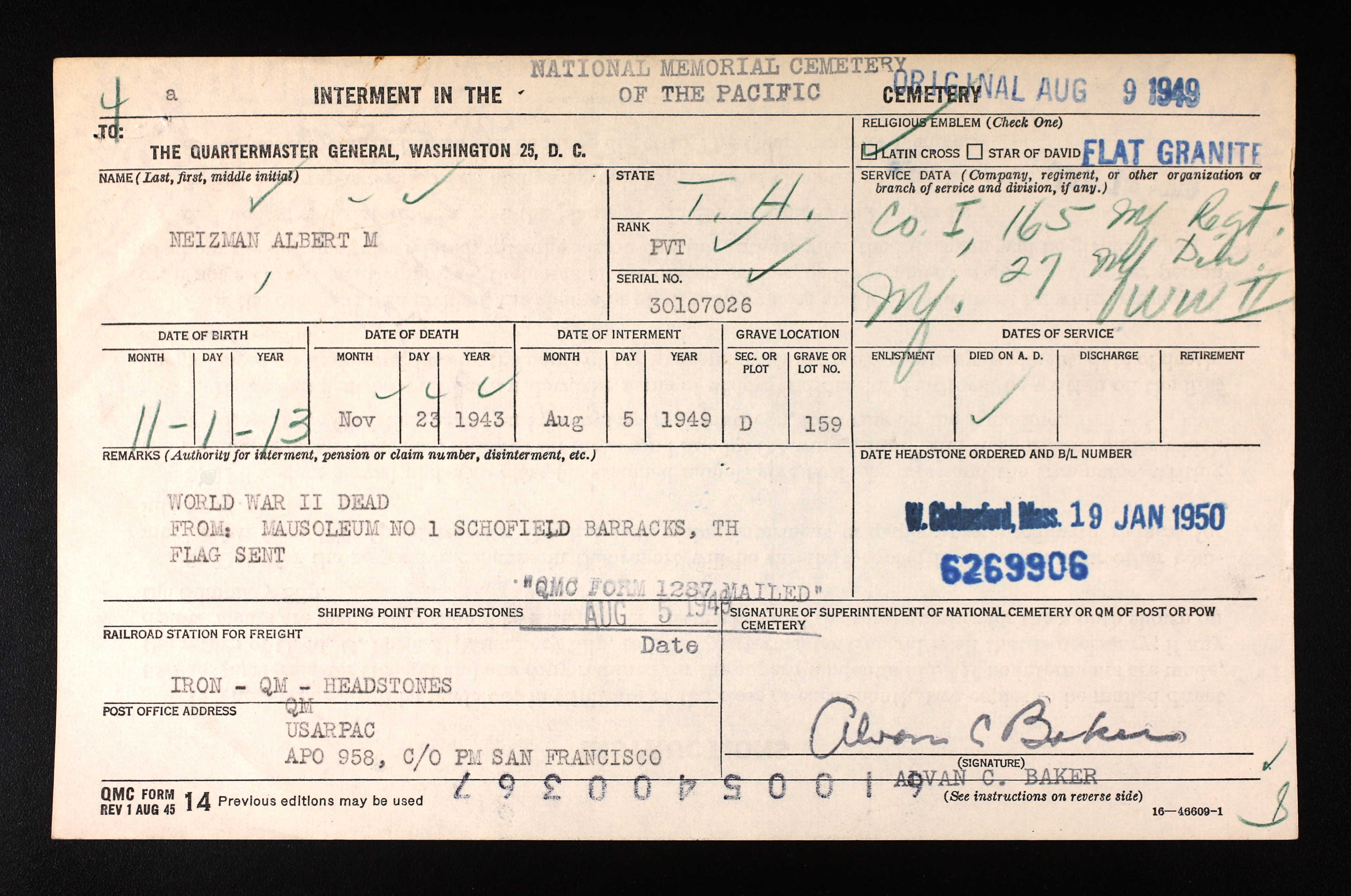Private Albert Menza Neizman

- Unit: 165th Infantry Regiment, 27th Division, Company I
- Service Number: 30107026
- Date of Birth: November 1, 1913
- Entered the Military: June 20, 1943
- Date of Death: November 23, 1943
- Hometown: Lahaina, Maui
- Place of Death: Makin Atoll, Gilbert Islands
- Award(s): Purple Heart
- Cemetery: Section D, Grave 159. National Memorial Cemetery of the Pacific, Honolulu, Hawai'i
Mentored by Ms. Janyce Omura
Maui High School
2018-2019
Early Life
Albert Neizman’s father, John, immigrated from Germany with his wife, Rosalia, to work as a mechanic on one of Kauai’s sugar mills. Later, they settled in Lahaina, Maui, where Albert was born, on November 1, 1913. Neizman was the eldest son of eight children. He had two sisters, named Mary and Cathryn, and five brothers: Frank, Joe, Peter, Thomas, and Manuel.
Before World War II, Neizman learned the fishing trade from Hawaiian elders and became a skilled fisherman. After completing his education at Kamehameha III School, he skipped high school to devote all his time to fishing in order to support his family. Neizman was self-employed and taught his brothers how to fish too. His nephew, James Neizman, remembered “Uncle Albert” taking him fishing when he was six years old.

Homefront
Maui Before World War II
Before World War II, the island of Maui was a rural community. The population of the island was approximately 47,000 people. In Hawaiʻi, the population was mainly comprised of immigrants who worked in the sugarcane fields. The immigrants came from places such as Japan, China, Korea, the Philippines, Spain, and Portugal. Each group carved out an area on the island, separate from each other, and maintained culture and language, which continues to shape Hawaiʻi’s diverse culture today.
Lahaina, Maui
At the time of World War II, Lahaina was a rural town. Front Street, where Neizman grew up, boasted many family-owned stores. Today, Lahaina is a resort town, attracting many tourists. Front Street, now a tourist attraction, is lined with name brand stores and art galleries.
Martial Law
After the attack on Pearl Harbor on December 7, 1941, President Roosevelt authorized martial law in the territory of Hawaiʻi. The U.S. military enforced strict laws, including curfews and blackout drills. The U.S. military also censored the press, radio, long-distance phone calls, and all mail. The massive surveillance was to make sure nobody, especially those of Japanese descent, made contact with the enemy. The large Japanese population living on the islands was monitored closely for fear that they were reporting back to the Japanese Imperial government. While some were interned, the government refrained from interning all Japanese immigrants and Japanese Americans as they feared it would harm Hawaiʻi overall economy. Given Hawaiʻi importance to the Pacific Theatre, the U.S. government needed to make sure the territory remained economically stable.
Martial law allowed the military to take over the civil court system. The writ of habeas corpus was suspended, and people were tried without a fair trial and given cruel and unfair punishments. Military personnel arrested about 2,000 people within the first two days of martial law. Martial law in Hawaiʻi lasted for three years.
U.S. Military in Hawaiʻi
Hawaiʻi became one of the central U.S. sites for operations in the Pacific Theatre. During the war, Maui experienced an influx of military personnel. The population grew to 200,000 people, due to the number of people moving in and out of the islands. Various locations such as Maalea, Puunene, and Haiku on the island became training grounds for all branches of the military.
To meet the needs of the military, a network of roads was built to get to isolated locations, and harbors were created to take in shipments of supplies. Sugarcane fields became training grounds for soldiers in the area. Given Hawaiʻi’s location, the U.S. government built airfields so that planes could land and refuel as they moved about the Pacific Theatre. These airfields built-in central Maui later became Maui’s airport after the war.

Military Experience
Neizman was inducted into the U.S. Army on June 20, 1943. He completed his training at the Schofield Barracks on Oahu, Hawaiʻi and was assigned to the 165th Infantry Regiment, 27th Division, Company I. He departed from Oahu on November 10, 1943, to fight in the Battle for the Gilbert Islands on the Makin Atoll.
The operation, code-named “Galvanic,” targeted Makin, Tarawa, and Apamama Atolls. In preparation for the assault on Makin Atoll, the 165th Infantry Regiment conducted joint amphibious training in Maalaea Bay on Maui and landing on Kahoolawe Island with simulated naval gunfire and air support.
Called into service in 1940, the 27th Infantry Division was initially part of the New York National Guard. The 27th Infantry Division was comprised of approximately 14,000 soldiers. Their first conflict was in the Makin Atoll in the battle for the Gilbert Islands, located 2,000 miles southwest of Oahu.
Strategically, the Japanese encampment in the Gilbert and Marshall Islands represented the outer reaches of the Japanese defense perimeter, which allowed them to expand into the Pacific Theatre. The Japanese presence interrupted supply lines and communications in the Pacific Theatre.
On Makin Atoll, the Japanese forces established a seaplane base to surveil U.S. ship and submarine movements allowing the Japanese to call in air and naval resources to meet the threats. Taking these series of Islands freed up military resources that kept the area in check and started the island-hopping campaign leading to Guam, Iwo Jima, and ultimately Japan.
Makin Atoll
The U.S. Army anticipated a Japanese fighting force of 800 men. While correct in their count, the Japanese had only 284 combat-ready troops who could defend their position.
The U.S. Army committed two landing parties to the southwestern end of the Atoll, intending to draw out the Japanese forces from behind their protected encampments. Several hours later, a third landing party swept in from the northwest to engage the Japanese from their flank. The Navy fired 1,717 tons of munitions on the island; however, the bombing did not have a material impact on the Japanese troops. Instead, bomb craters combined with the swampy terrain would become obstacles for the Army’s tanks and armored vehicles to maneuver on the Atoll.
The Japanese Army put up nominal resistance at the landing sites; choosing to engage with the American troops from behind fortified tank traps. Due to the potential for crossfire on American forces on either side, tank and artillery firepower were rendered useless. The Japanese military strategy effectively funneled the American troops through a densely vegetated and narrow, 150-yard battlefield, which forced the American soldiers into a one on one fighting through each bunkered position.
After several days of fighting, the American forces overcame the Japanese soldiers and took possession of the Atoll on November 23, 1943. American ground casualties totaled to 66 killed in action and 152 wounded. American troops killed approximately 395 Japanese in the battle. Sadly, in the early morning hours following the completion of the land battle, on Makin Atoll, the USS Liscome Bay, an escort carrier, was sunk by a Japanese submarine torpedo. The Navy lost 644 crewmen on the USS Liscome Bay and is considered the most devastating loss of a sunken carrier in the history of the U.S. Navy. The total number of U.S. troops killed in the battle nearly equaled the size of the Japanese contingent on Makin Atoll.
Private Neizman was one of the 66 soldiers killed in battle. He was shot and killed on the last day of fighting, earning him the Purple Heart for his sacrifice and bravery.
Eulogy
Private Albert M. Neizman was drafted in the Army at the age of 30. Before the war, Albert learned the fishing trade from Hawaiian elders and became a skilled fisherman. In an interview with his nephew, James Neizman, he recalled the first time his uncle took him fishing when he was six years old. His uncle taught him and his brothers how to fish, the “old Hawaiian” way. And although Army records state that Private Neizman was only 5’ 5,” James remembers him as a larger-than-life figure.
The battle for the Makin Atoll was fierce, and despite the losses, the battle cleared navigation lanes to Australia and the Southwest Pacific. The U.S. was able to establish a base of operations for its next target, the Marshall Islands. The Army’s assessment of the battle yielded valuable lessons for its advance through the Pacific.
Private Neizman was killed in action from a bullet wound on November 23, the last day of fighting on Makin Atoll, only five months after joining the Army. For his sacrifice and bravery, Private Neizman earned the Purple Heart.
Albert M. Neizman, thank you for your bravery and sacrifice to preserve our freedom.

Reflection
The Sacrifice for Freedom®: Student and Teacher Institute provided the opportunity to learn about the Pearl Harbor attack and other history and events surrounding World War II. We had a number of amazing learning opportunities on this trip, my favorites being the trip to the USS Missouri, Japanese Cultural Center, and the National Memorial Cemetery of the Pacific.
On the U.S.S. Missouri we got a little taste of what it was like to live like a sailor. We slept in the same bunks, conducted morning and evening colors, and toured the ship. I did not realize that a ship could be so big.
The biggest impact the trip to the USS Missouri had on me was when a U.S. Navy veteran retold the story of the peace treaty between Japan and the United States being signed on the ship. It was like reliving history.
At the Japanese Cultural Center we learned about the untold story of the Honouliuli internment camp and the Japanese American involvement in the war.
At the Japanese Cultural Center I was able to give a briefing about the 442nd Regimental Combat Team and 100th Battalion. I was able to briefly talk about my Dad’s great uncle, Katsuyoshi Hamamoto, who was a part of the 442nd Regimental Combat Team. At the center, I also spotted his name on a wall of all those who died serving with the 442nd Regimental Combat Team.
The visit was also impactful for me because I had a great great uncle, Thomas Sakakihara, who was interned at Honouliuli and I finally got to hear part of the story. I had not realized how harsh the conditions of an internment camp really were until we visited the Honouliuli internment camp.
At the National Cemetery of the Pacific, I was initially stunned at how beautiful it was. It made me happy to know that the brave soldiers who had served were resting in such a beautiful place. I felt more connected to Private Neizman and even more honored and grateful to give his eulogy.
I am so thankful for this experience and the opportunity to learn and honor a brave soldier.
Bibliography
Primary Sources
“Albert M. Neizman.” Honolulu, Hawaii, National Memorial Cemetery of the Pacific (Punchbowl), 1941-2011. Digital Images. ancestry.com.
“Albert M. Neizman.” U.S. National Cemetery Internment Control Forms, 1928-1962. Digital Images. ancestry.com.
“Albert M. Neizman.” World War II Army Enlistment Records, 1938-1946. Digital Images. ancestry.com.
Front Street, Lahaina. 1910s. Photograph. Hawaii State Archives (PP-50-3-024). www.hawaiimagazine.com/content/7-amazing-old-photos-popular-hawaii-attractions.
Lee, Lloyd L., Editor. In freedom’s cause; a record of the men of Hawaii who died in the second World War. Honolulu: University of Hawaii, 1949.
“Maui Soldier is Reported Killed.” Honolulu Star-Bulletin, December 14, 1943.
Neizman, James. In person by the author. June 23, 2019.
U.S. Territory of Hawaii – University of Hawaii. Memorial Record of Residents of Hawaii Who Have Died In Military Service. 1947.
Secondary Sources
County of Maui. General Plan 2030 Maui Island Plan Maui Island History: Lessons From The Past – A Guide To The Future. Wailuku: Christ Hart & Partners Inc., September 2006. www.mauicounty.gov/DocumentCenter/View/10483/GP-2030-Maui-Island-History-Report?bidId=.
Herreria, Carla. “Forbidden Photos Reveal What Life in Hawaii Was Like After Pearl Harbor.” Huffington Post. Updated December 7, 2016. Accessed August 18, 2019. www.huffpost.com/entry/hawaii-pearl-harbor-attacks-photographs_n_58462170e4b055b313990dad.
Makin. Washington D.C.: U.S. Center of Military History, 1946. history.army.mil/html/books/100/100-2/CMH_Pub_100-2.pdf
“Maui’s World War II History.” Valley Isle Excursions. Last modified 2014. Accessed September 8, 2019. www.tourmaui.com/world-war-2-history/.
“Maui’s World War II Legacy: The History of Maui During the War Years.” National Oceanic & Atmospheric Administration, Updated July 31, 2017. Accessed August 15, 2019. sanctuaries.noaa.gov/maritime/expeditions/maui/history.html.
Scheiber, Jane and Harry Scheiber. “Martial law in Hawaii.” Densho Encyclopedia. Accessed August 18, 2019. encyclopedia.densho.org/Martial%20law%20in%20Hawaii/.

